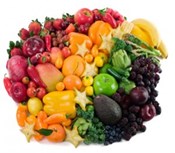Summer is the perfect time for healthy eating. Many fruits are at their peak for freshness and flavor. They can be a great addition to any meal or a tasty snack. By choosing fruit instead of other high-calorie snacks, your body is able to maintain a healthier weight.
Fruits are naturally low in fat, sodium, and calories, and they contain several important nutrients, including vitamins A and C. These vitamins help with vision, healing, and fighting infections. The fiber in fruit can also help to lower cholesterol. Fruit may also help reduce your risk for heart disease, diabetes, and high blood pressure. By choosing fruits of every color, your body will get the nutrients it needs to gain all of these benefits.
MyPlate recommends half of your plate should be filled with fruits and vegetables, but how much is that? Adults should get about 2 cups of fruit each day. In general, 1 cup of fruit or 100% fruit juice, or 1/2 cup of dried fruit can be considered as 1 cup from the Fruit Group.
Tips:
• Fruits are less expensive and typically taste better when they are in season.
• When buying canned fruits, choose them in 100% juice rather than in syrup.
• Limit your fruit servings from juice, try whole fruit instead.
• Replace high fat and sugar desserts with fruit.
• Wash all fruits with water before peeling and/or eating.
When purchasing fruit, it is important to know how to tell if it is at the peak of ripeness. Some fruit actually continues to ripen after it is picked. These fruits can be purchased early and sit out on the counter for a few days. Some examples of these are apricots, bananas, cantaloupe, kiwi, peaches, plums, and pears. To speed ripening, put the fruit in a loosely closed brown paper bag at room temperature. For a guide on how to select ripe fruit go to http://go.unl.edu/8gp.
Source: Kristen Houska and Erika Harms, The Nebline, University of Nebraska-Lincoln, August 2012







